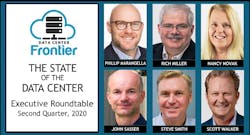Executive Roundtable: The Pandemic’s Impact on Data Center Operations
Welcome to our 19th Data Center Executive Roundtable, a quarterly feature showcasing the insights of thought leaders on the state of the data center industry, and where it is headed. Our Second Quarter 2020 roundtable offers insights on four aspects of the COVID-19 pandemic: the impact on data center staffing and operations, how enterprises are evaluating their IT options, what a more distributed workforce means for edge computing, and the outlook for the data center supply chain through the pandemic.
Here’s a look at our distinguished panel:
- Phillip Marangella, Chief Marketing Officer at EdgeConneX.
- Steve Smith, the Chief Revenue Officer for CoreSite.
- Nancy Novak, Chief Innovation Officer at Compass Datacenters and Advisory Council member for Infrastructure Masons.
- Scott Walker, Senior VP of Sales at NTT Global Data Center Americas.
- John Sasser, Senior Vice President of Data Center Operations at Sabey Data Centers.
The conversation is moderated by Rich Miller, the founder and editor of Data Center Frontier. Each day this week we will present a Q&A with these executives on one of our key topics. We begin with a look at our panel’s outlook for the COVID-19 pandemic’s impact on data center staffing and operations.
Data Center Frontier: Data center staffing was already a challenge as we entered 2020. What is the impact of the COVID-19 crisis on data center staffing and operations, both in the short-term and long-term?
NANCY NOVAK, Compass Datacenters and iMasons
Nancy Novak: I think COVID has impacted data center operations in a few ways. First, I think that it’s illustrated that for all of the automated and software-based capabilities that support data centers, the essential element for ensuring their ubiquitous level of availability is still the people who physically operate the facility. That’s a good thing, because I believe that sometimes we try to implement technological solutions to solve problems or perform tasks that are better conducted by technicians providing hands on-support.
The crisis has definitely forced the industry to re-evaluate operational processes and procedures that have probably reached the counter-productive “we’ve always done it this way” threshold. For example, can shift changes be conducted indirectly or maintenance schedules modified in terms of their frequency or timing without negatively impacting facility performance? While no one likes having a pandemic be a catalyst for re-examining the way we do business, it has shown us how easy it for complacency to diminish our focus on continually improving our operations.
As to the future, I think it would be fair to say that COVID illuminated our lack of depth in terms of personnel with skill sets to support our facilities; a situation that will be exacerbated due to the obvious accelerating need for data center capacity in the coming years. From a positive perspective, we emerge post-pandemic with a clearer understanding of how necessary it is for the industry to become more actively involved in promoting efforts in areas such as encouraging more woman and minorities to pursue STEM-related careers to both diversify, but more importantly, broaden the base of talent to draw from to meet growing demand.
PHILLIP MARANGELLA, EdgeConneX
Phillip Marangella, EdgeConneX: Now, more than ever, enterprises and hyperscalers require the ability to easily manage, monitor and enable their data center assets and operations across an expanding global footprint with a secure view into their infrastructure, from anywhere, at any time. With travel restrictions in place and remote work becoming quasi-permanent, access to remote monitoring and management solutions has become essential. While empowering organizations with business continuity, these solutions ensure the health and safety of IT staff, vendors, partners and customers.
To efficiently operate global data centers remotely and better serve customers, data center operating systems that go beyond the common DCIM platform are vital. These solutions, including the EdgeConneX proprietary EdgeOS solution, enable clients to manage, monitor and control their global data center assets, operations, and footprint from a single pane of glass, from anywhere, 24 hours a day.
Automating the data center as much as possible and putting the customer at the center of operational systems creates operational efficiency and scale to support the fastest response times for every type of customer, regardless of issue, size of deployment, need or location.
JOHN SASSER, Sabey Data Centers
John Sasser, Sabey Data Centers: We are continually searching out new talent and have an internal process for training and advancing our people to ensure that they are completely immersed in our standard operating procedures and in our culture of excellence and customer service. Because of the cohesiveness that our culture creates among our team members, moving to modified schedules and assigning some people to work from home was relatively easy and has resulted in no irremediable diminishing of efficiency, safety and responsiveness.
The goal was to reduce physical contact thereby reducing the transmission of the virus to both customers and the team and mitigating the risk of multiple team members getting sick at the same time, and we’ve been rewarded with excellent results. We found this was effective as a temporary solution, especially when coupled with a reduced operations tempo, i.e., deferring discretionary projects and maintenance where possible.
Long term, as unwelcome as the COVID epidemic has been, it has also served as a forcing function for considering other operations procedures and for investing in automated solutions. We also expect to see more robust offerings for Remote Hands assistance as customers limit the exposure of their people to a stricter criterion of need. We’ve certainly experienced a marked uptick in remote hands services from customers who formerly did some of this type of work in-house.
STEVE SMITH, CoreSite
Steve Smith, CoreSite: Cross-functional training has always been an essential component of a capable data center operations team. It’s become even more critical as we staff our data centers during the COVID-19 pandemic. Data centers are naturally conducive to social distancing practices, thanks to their sizeable square footage compared to the number of people in the building at any given time. However, customers can now monitor equipment and peak loads, and communicate with data center staff remotely via our online portal.
Here at CoreSite, we have a rigorous cross-functional training program for our data center operations staff, which prepared us to have fewer employees on-site and the same broad skillset. This training has been focused on short-term incidents such as hurricanes and floods, but transitioned well to our longer-term predicament. As a result of our flexible staffing model, we have been able to maintain our scheduled maintenance. We are also lucky to employ many veterans in our data centers; veterans staff approximately 50 percent of our mission-critical roles. Our workforce is well versed in problem solving, adaptability and diligence.
The data center industry has predicted a future shortage of a technically-skilled workforce. How do we fill that gap? How do we encourage a younger generation, particularly women, to pursue careers in this industry? It’s an answer we are thinking about in our recruiting efforts.
SCOTT WALKER, NTT Global Data Centers, Americas
Scott Walker, NTT Global Data Centers: I speak for our executive management team when I say that overall, we have not experienced any negative impacts to staffing and are in fact hiring new employees in many departments as we continue building our new data center campuses in Chicago, Hillsboro, and Silicon Valley, as well as our newest data center on our 78-acre Ashburn campus.
All of our non-essential employees were given the appropriate equipment to work productively away from our data centers until further notice. We’re very happy with the cooperative spirit our employees have shown to date. Supervisors are in regular contact with their teams, and all reports have indicated that productivity has not declined during this crisis.
There are some employees who have to continue working at their data center site due to their roles within our operations team. To protect our employees and our customers, we have implemented mandatory social distancing, use of extensive personal protective equipment, high-tech temperature screenings, and standard COVID-19 related questions at the security entrance.
As far as long-term effects from the pandemic, we feel that this crisis has underlined the importance of keeping society connected via remote channels. Data centers play an essential role in that objective. To that end, we anticipate a continued need for talented personnel to keep data centers running smoothly, reliably, and economically. We look forward to continuing to add the best and brightest to our team.
NEXT: How the pandemic is impacting enterprise IT strategy.
Keep pace with the fact-moving world of data centers and cloud computing by following us on Twitter and Facebook, connecting with me on LinkedIn, and signing up for our weekly newspaper using the form below:
About the Author





